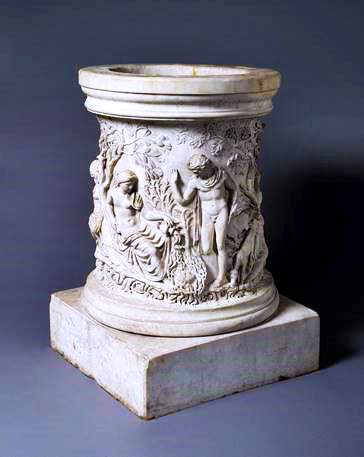An outstanding example of an ancient Roman figural relief sculpture that was recently acquired by The Metropolitan Museum of Art is now on display. The impressive marble wellhead (also known as a puteal) dates from the second century AD. The sculpture once covered a well in Ostia, the port town of ancient Rome. The ancient sculptor masterfully carved the wellhead from a single block of marble, effectively transforming what otherwise would be considered a utilitarian object into a decorative piece of the highest order. The wellhead features two cautionary tales about water from Greek mythology. The narrative relief combines the legend of Narcissus and Echo with the tragic story of the abduction of Hylas by nymphs. Of the 70 or so Roman marble wellheads with relief decoration known today, The Met’s is one of the finest and the only one whose iconography relates so directly to water.
“This puteal is the finest example of ancient Roman marble sculpture to enter The Met’s collection in well over half a century,” said Max Hollein, Director of the Museum. “The virtuosic carving and moving narrative are captivating and we’re honored to introduce this exceptional object to our audiences.”
Narcissus and Echo are probably best known to the modern public from the description in Ovid’s Metamorphoses. In the story, a spurned lover of Narcissus curses him to love only himself. The wellhead’s image of Narcissus is particularly dramatic: entranced by his own reflection in the water, his long locks of hair flow in the rushing water, while Echo sits behind him, hopelessly in love. In the Argonautica, an epic poem by Apollonios of Rhodes, the handsome hero Hylas is fetching water when he disturbs the dance of water nymphs and one of them becomes love-struck, pulls him into the water and he disappears. The same story appears in Roman Imperial wall painting, where, as here, several nymphs are typically involved. The composition on the wellhead may stem from a famous, now-lost Hellenistic painting.
The wellhead measures approximately 41 inches in height and 26 inches in diameter. It was excavated in 1797 in one of the last private excavations on Papal lands. At the time of its discovery it was celebrated as one of the most beautiful Roman sculptures of its kind. In 2020, as part of the 150th anniversary of The Met, the wellhead will be featured in an exhibition that will take a close look at the sculpture’s remarkable history and iconography.
The Metropolitan Museum of Art is located at 1000 Fifth Avenue in New York City. For more information call 212-535-7710.





